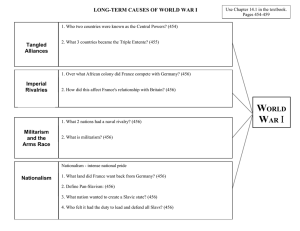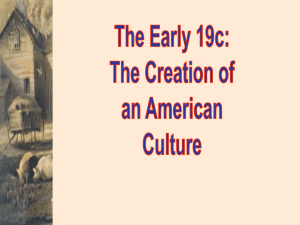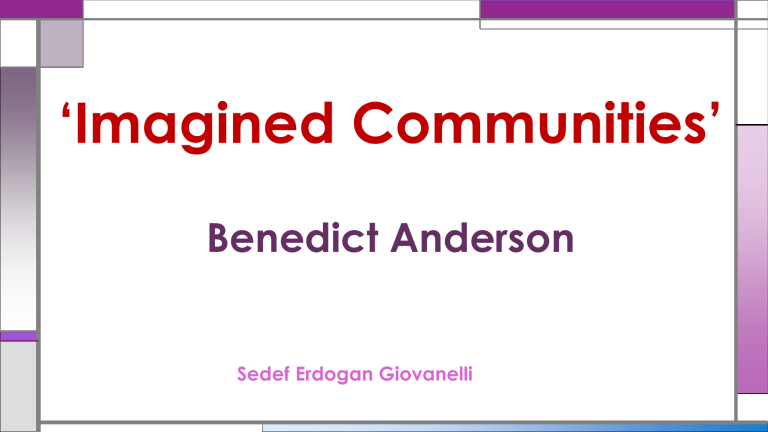
‘Imagined Communities’ Benedict Anderson Sedef Erdogan Giovanelli Presentation Overview Chapter 1: Introduction Chapter 2: Cultural Rules Chapter 3: The Origins of National Consciousness Chapter 4: Creole Pioneers Chapter 5: Old Language, New Models Chapter 6: Official Nationalism and Imperialism Chapter 7: The Last Wave Chapter 8: Patriotism and Nationalism Chapter 9: The Angel of History Chapter 10: Census, Map, Museum Chapter 11: Memory and Forgetting Some Criticism on Imagined Communities Discussion Questions Overview *Modernist school of nationalism *Utopian element in nationalism *A form of social constructionism with Edward Said’s concept of imagined geographies * Benedict Anderson’s Imagined Communities traces the origins of the rise of national consciousness to the modern-industrial age of the Enlightenment in Western Europe. Chapter 1: Introduction *The issues concerned with the term nationalism. *Theorists of nationalism have encountered three paradoxes; 1. Modernity of nations vs their subjective antiquity 2. Nationality as a socio cultural concept vs its manifestations 3. The political power of nationalism vs its philosophical poverty ‘Imagined Communities’ • A nation is a community socially constructed community and imagined • ‘An imagined political community that is both limited and sovereign’ • Imagined members cannot all know each other • Limited no nation encompasses all of mankind • Sovereign nations emerged during Enlightenment and strive for freedom • Community people are connected with brotherhood Why? • Why is it that these limited imaginings of brotherhood, which have existed for only two centuries, have inspired millions of people to kill and die for a country? Chapter 2: Cultural Rules • What was happening in Europe in the 18th century? – Religion – Dynastic realms – Enlightenment and rationalist secularism – Nations imagine themselves as a glorious past –Hope Result: A new way of linking brotherhood, power and time together. Chapter 3: The Origins of National Consciousness • Development of print – Community united in time and feeling of belonging • Capitalism • Expansion of book market -Vernacularization of language Print Capitalism • 15th century, focused shifted to vernaculars • Use of administrative vernaculars began spreading in Europe • A new fixity, standarization, image of antiquity Chapter 4: Creole Pioneers • Creole states “formed and led by people who shared a common language and origin with those against whom they fought”. • The earliest to develop conceptions of nation-ness Chapter 5: Old Languages, New Models • National print languages • Piracy • The impact of the ‘discoveries’ • Lexicographers, grammarians, and composers were producers for the print market, they were linked to the consuming public. • National liberation movements in Americas - Nationalism in Europe Chapter 6: Official Nationalism and Imperialism • The lexical revolution and rise of European nationalist movements • Print vernaculars as languages of state • The ‘naturalizations’ of Europe’s dynasties • The model of official nationalism -popular linguistic-nationalisms Chapter 7: The Last Wave • From colonial state to a national state • Increase in physical mobility, bureaucracy, modern-style education • The intelligentsias • ‘Nation-building’ policies through the mass media, the educational system, administrative regulations, and so forth - Chapter 8: Patriotism & Racism • Nationalism with affinities to racism, hatred of the Other, but… • Nations inspire love, shown in poetry, prose, music, arts. • Death & History Chapter 9: The Angel of History • Revolutions are contemporary exhibits of nationalism • Imagined communities has spread to ever possible contemporary society Chapter 10: Census, Map, Museum • A census: Created identities by the classifying mind of colonial state • Map: Designed to demonstrate the antiquity of specific units • Museum: A guardian of tradition Chapter 11: Memory and Forgetting • Parallelism of states- It was possible to imagine a vast parallelism of simultaneous states, inspiring revolutions and nationalism in the America Some Criticism on Imagined Communities • Anderson’s definition do not recognize nationalism as a lived idea, or an experience…..(Niels Kayser Nelson) • Lack of representation of the Arab world (Fadia Rafeedie) • Nationalism could be unproblematically exported from Europe to postcolonial societies Conclusion • The main aim of this work is to offer clarifications for the irregularities concerned with Nationalism • The creation and global spread of the imagined communities of nationality, and explores the processes that created these communities: the ongoing decline of religious faiths the decline of antique kinship the interaction between capitalism and print the development of secular languages-of-state changing conceptions of time and space Discussion Questions 1. Do you agree with Anderson’s definition of the nation? Why? Why not? 2. To what extent do you agree with Benedict Anderson and his view that nationalism is a force for good? 3. How does this compare with Turkey and Turkish nationalist movements? Can you give some examples? 4. Do you agree that cultural events create and reinforce imagined communities, for example, how effective was the London 2012 Olympics in conveying an imagined community? http://theinspirationroom.com/daily/2007/england-never-surrender/ 5. How do you see the “imagined communities” growing and spreading their nationalism in new areas in the modern world? Can you relate it to Turkish context?
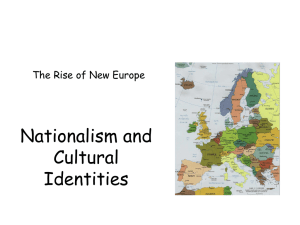
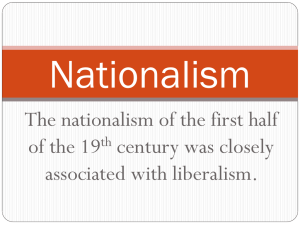
![“The Progress of invention is really a threat [to monarchy]. Whenever](http://s2.studylib.net/store/data/005328855_1-dcf2226918c1b7efad661cb19485529d-300x300.png)

